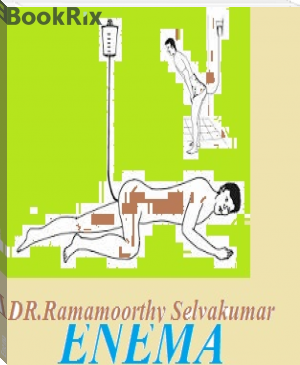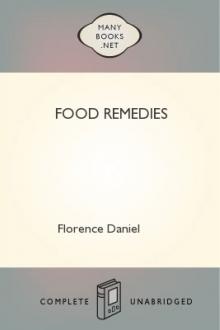Enema by DR. Ramammoorthy Selvakumar (best android ereader txt) 📕

- Author: DR. Ramammoorthy Selvakumar
Book online «Enema by DR. Ramammoorthy Selvakumar (best android ereader txt) 📕». Author DR. Ramammoorthy Selvakumar
Enema is the one treatment of naturopathy
Naturopathy is a one of the good way for human life wastage things in your body make it a disease how to remove your wastage about your body making with good health this is speaking in the one of the therapy about in enema one of the good therapy...
now the days we are all eat so many contaminated things input condition is too much bad today life anything any food any oil all are mixed about business times world make a money for poisonous about mixing it
Daily Motion not passed it's very morning actress come sometime motion if we stop today nhb nature way way it is not good invest is staying in your body making poison about universe organ and detached in your plate blood so bad it's making for any disease so the conditions of the valley one litre of plain water in the enema can and take at Enema be better
about the plain water enema was a cure about constipation problems and more than stomach problems fever and liver problems calso clean body will be taken relax and relief it's simply only plan water is enough plan water is not good
take plan water boield it after comming cold use with Enema can to take Enema be better It is cure so much illness in your body make it fit read about more History of Enema
Enema photo of 15th century African annimal view
At Enema
Alternative medicine — or fringe medicine — includes practices claimed to have the healing effects of medicine but which are disproven, unproven, impossible to prove, or are excessively harmful in relation to their effect; and where the scientific consensus is that the therapy does not, or can not, work because the known laws of nature are violated by its basic claims; or where it is considered so much worse than conventional treatment that it would be unethical to offer as treatment. Alternative therapies or diagnoses are not part of medicine or science-based healthcare systems. Alternative medicine consists of a wide variety of practices, products, and therapies—ranging from those that are biologically plausible but not well tested, to those with known harmful and toxic effects. Contrary to popular belief, significant expense is paid to test alternative medicine, including over $2.5 billion spent by the United States government. Almost none show any effect beyond that of false treatment. Perceived effects of alternative medicine may be caused by placebo; decreased effect of functional treatment (and therefore potentially decreased side effects); and regression toward the mean where improvement that would have occurred anyway is credited to alternative therapies; or any combination of the above. Alternative treatments are neither the same as experimental medicine, nor traditional medicine — although the latter, when used today may be considered alternative.
Alternative medicine has grown in popularity and is used by a significant percentage of the population in many countries. While it has extensively rebranded itself: from quackery to complementary or integrative medicine—it promotes essentially the same practices. Newer proponents often suggest alternative medicine be used together with functional medical treatment, in a belief that it "complements" (improves the effect of, or mitigates the side effects of) the treatment. There is no evidence showing they do so, and significant drug interactions caused by alternative therapies may instead negatively influence treatments, making them less effective, notably cancer therapy. Despite being illegal to market alternative therapies for cancer treatment in most of the developed world, many cancer patients use them.
Alternative medical diagnoses and treatments are not taught as part of science-based curricula in medical schools, and are not used in any practice where treatment is based on scientific knowledge or proven experience. Alternative therapies are often based on religion, tradition, superstition, belief in supernatural energies, pseudoscience, errors in reasoning, propaganda, fraud, or lies. Regulation and licensing of alternative medicine and health care providers varies between and within countries.
Alternative medicine is criticized for being based on misleading statements, quackery, pseudoscience, antiscience, fraud, or poor scientific methodology. Promoting alternative medicine has been called dangerous and unethical. Testing alternative medicine that has no scientific basis has been called a waste of scarce research resources. Critics state "there is really no such thing as alternative medicine, just medicine that works and medicine that doesn't", and the problem with the idea of "alternative" treatments in this sense is that the "underlying logic is magical, childish or downright absurd". It has been strongly suggested that the very idea of any alternative treatment that works is paradoxical, as any treatment proven to work is by definition "medicine".
What Was Enema?Clyster (/ˈklɪstə(r)/), also spelled glister in the 17th century, rarely "cloister" or "clister" comes from Greek κλυστήρ (klystḗr), from κλύζω (klýzo), "(I) wash". It is an archaic word for enema, more particularly for enemas administered using a clyster syringe – that is, a syringe with a rectal nozzle and a plunger rather than a bulb. Clyster syringes were used from the 17th century (or before) to the 19th century, when they were largely replaced by enema bulb syringes, bocks, and bags.
The first mention of the enema in medical literature is in the Ancient Egyptian Ebers Papyrus (c. 1550 BCE). One of the many types of medical specialists was an Iri, the Shepherd of the Anus. Many medications were administered by enemas.There was a Keeper of the Royal Rectum who may have primarily been the pharaoh's enema maker. The god Thoth, according to Egyptian mythology, invented the enema.
The Olmec from their middle preclassic period (10th through 7th centeries BCE) through the Spanish Conquest used trance-inducing substances ceremonially, and these were ingested via, among other routes, enemas administered using jars.
The Maya in their late classic age (7th through 10th centuries CE) used enemas for, at least, ritual purposes, in the Xibalban court of the God D whose worship included ritual cult paraphernalia. It is hypothesized that these enemas were for ritual purification and the ingestion of intoxicants and hallucinogens. The Maya illustrated the use of a characteristic enema bulb syringe by female attendants administering clysters ritually.
Pressure enema from an animal bladder (African wooden sculpture, 19th century)
In the second century CE the Greek philosopher Celsus recommended an enema of pearl barley in milk or rose oil with butter as a nutrient for those suffering from dysentery and unable to eat and Galen mentions enemas in several contexts.
In medieval times appear the first illustrations of enema equipment, a clyster syringe consisting of a tube attached to a pump action bulb made of a pig bladder and the 15th century Simple piston syringe clysters came into use. Beginning in the 17th century enema apperatus was chiefly designed for self-administration at home and many were French as enemas enjoyed wide usage in France.
When clyster syringes were in use in Europe, the patient was placed in an appropriate position (kneeling, with the buttocks raised, or lying on the side); a servant or apothecary would then insert the nozzle into the anus and depress the plunger, resulting in the liquid remedy (generally, water, but also some other preparations) being injected into the colon.
Portable enema self-administration apparatus by Giovanni Alessandro Brambilla (18th century; Medical History Museum, University of Zurich)
Because of the embarrassment a woman might feel when showing her buttocks (and possibly her genitals, depending on the position) to a male apothecary, some contraptions were invented that blocked all from the apothecary's view except for the anal area. Another invention was syringes equipped with a special bent nozzle, which enabled self-administration, thereby eliminating the embarrassment.
Clysters were administered for symptoms of constipation and, with more questionable effectiveness, stomach aches and other illnesses. In his early-modern treatise, The Diseases of Women with Child, François Mauriceau records that both midwives and man-midwives commonly administered clysters to labouring mothers just prior to their delivery.
In the 16th century, satirists made physicians a favorite target, resembling Molière's caricature whose prescription for anything was "clyster, bleed, purge," or "purge, bleed, clyster.
In Roper's biography of his father-in-law Sir Thomas More, he tells of Thomas More's eldest daughter falling sick of the sweating sickness. She could not be awakened by doctors. After praying, it came to Thomas More:
There straightway it came into his mind that a clyster would be the one way to help her, which when he told the physicians, they at once confessed that if there were any hope of health, it was the very best help indeed, much marveling among themselves that they had not afore remembered it.
Utopia, Thomas More 19th century satirical cartoon of a monkey rejecting an old style clyster for a new design, filled with marshmallow and opium
In the 18th century tobacco smoke enemas were used to resuscitate drowned people. Tobacco resuscitation kits consisting of a pair of bellows and a tube were provided by the Royal Humane Society of London and placed at various points along the Thames.
Clysters were a favourite medical treatment in the bourgeoisie and nobility of the Western world up to the 19th century. As medical knowledge was fairly limited at the time, purgative clysters were used for a wide variety of ailments, the foremost of which were stomach aches and constipation.
Molière, in several of his plays, introduces characters of incompetent physicians and apothecaries fond of prescribing this remedy, also discussed by Argan, the hypochondriac patient of Le Malade Imaginaire. More





Comments (0)